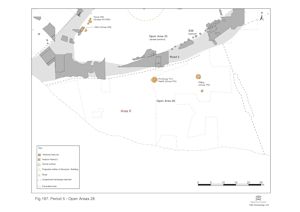
With Building 39 demolished during Period 4, there is seemingly little other than pitting occupying the OA28 interior during the Late Roman period (Figure 187). It is a distinct possibility that the enclosure is simply absorbed into OA50 by this time, although there are no new east-west aligned boundaries imposed that disrupt its former layout, as is the case for former OAs 24-27.

Inter-cutting pits 4379 and 4429 (Group 741) lie close to Road 3. Both contain large animal bone components and 4429 a significant quantity of oyster shell.
A further three late 3rd to mid-4th century pits (4702, 4873, 14125 Group 743) are located in the east of the enclosure. This group also includes unplanned features 4314 and 4805.
The Late Roman pits vary in size from under 1m to 2.35m width and from 0.30m to 0.78m deep. All lie within 15m of the edge of Road 3 and of these, only pit 4873 is further than 10m from it. From the excavated and dated sample, the pits of this date appear to be scattered and rarely inter-cutting.
While some of the pits contain relatively large and varied finds assemblages, they nonetheless appear smaller than those of comparable date in other areas of the settlement. Pottery and tile contents are generally high, but the quantity of other material types varies from pit to pit. Some have significant metalwork content, largely iron, while pits 4379 and 4429 contain large animal bone components. It appears that only pits of this late date, such as 4429 and 14125, contain significant quantities of oyster shell.
A shallow cut 4378 (Group 742), little more than a scoop into the contemporary ground surface, contains a burnt clay lining (4345) overlying a layer of black charcoal and clay (4364). The fills also include pottery, tile and flint pebbles, all of which are burnt. This feature is probably a hearth and is of late 3rd to mid-4th century date. It is set centrally on/in the fills of underlying pit 4379 (Group 741) and it is likely that 4378 is not an actual cut but represents use of a slump hollow over the pit. The hearth also post-dates the infilling of pit 4429.
Internet Archaeology is an open access journal based in the Department of Archaeology, University of York. Except where otherwise noted, content from this work may be used under the terms of the Creative Commons Attribution 3.0 (CC BY) Unported licence, which permits unrestricted use, distribution, and reproduction in any medium, provided that attribution to the author(s), the title of the work, the Internet Archaeology journal and the relevant URL/DOI are given.
Terms and Conditions | Legal Statements | Privacy Policy | Cookies Policy | Citing Internet Archaeology
Internet Archaeology content is preserved for the long term with the Archaeology Data Service. Help sustain and support open access publication by donating to our Open Access Archaeology Fund.